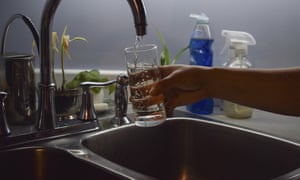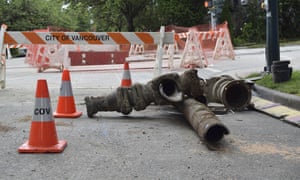Canada
Canadians exposed to high levels of lead in drinking water, investigation finds
Levels exceed federal guidelines for hundreds of thousands
18% of test results exceed far laxer US standard

Florabela Cunha fills a glass of water from her kitchen faucet in Prince Rupert, British Columbia, Canada. Hundreds of thousands of Canadians have been unwittingly exposed to lead. Photograph: Mackenzie Lad/AP
Hundreds of thousands of Canadians have been unwittingly exposed to high levels of lead in their drinking water, according to an investigation that tested drinking water in hundreds of homes and reviewed thousands more previously undisclosed results.
Residents in some homes in Montreal and Regina, in the western prairies, are among those drinking and cooking with tap water with lead levels that exceed Canada’s federal guidelines. The investigation found some schools and daycare centers had lead levels so high that researchers noted it could harm children’s health.
A yearlong investigation by more than 120 journalists from nine universities and 10 media organizations, including the Associated Press and the Institute for Investigative Journalism at Concordia University in Montreal, collected test results that properly measure exposure to lead in 11 cities across Canada. Out of 12,000 tests since 2014, one-third – 33% – exceeded the national safety guideline of five parts per billion; 18% exceeded the US limit of 15 ppb.
Leona Peterson learned of the contamination in her water after journalists found excessively high lead levels in 21 of 25 homes tested in her small, north-west port town of Prince Rupert. Peterson, who lives in subsidized housing for Indigenous people, had water that registered at 15.6 ppb.
“I was drinking from the tap, directly from the tap, without any knowledge that there was lead in the water,” said Peterson.
The town of Prince Rupert is among more than a dozen communities along Canada’s wild west coast where residents – many of them Indigenous – are living in homes with ageing pipes, drinking corrosive rainwater that is likely to draw lead.
Some localities are taking action. Montreal’s mayor, Valérie Plante, vowed to test 100,000 homes for lead and speed up replacement of lead-lined pipes

FacebookTwitterPinterest Unearthed pipes lie on Vancouver’s East 12th Avenue, which is undergoing construction to replace a water main on 14 July 2019. Photograph: Mackenzie Lad/AP
“Because there is no federal oversight, everybody does what they want,” said engineering professor Michèle Prévost, who quit working on a government study of school drinking water in frustration over the lack of lead testing. “Most provinces ignore this very serious problem.”
The government’s approach to limiting lead in drinking water in Canada is starkly different from the US, where the Environmental Protection Agency sets legal standards, and every person is supposed to receive an annual Consumer Confidence Report from their water provider.
There is no similar, routine testing or notice in Canada, with the exception of Ontario, which posts results online.
In the US, even public water quality reports were not enough to prevent the Flint, Michigan drinking water crisis, brought on by a 2014 decision to temporarily pull water from a river as a cost saver while installing new pipelines.
The Flint crisis sparked congressional hearings, lawsuits and scrutiny of lead testing across the country. In Canada, where lawsuits are less frequent and provinces – not the federal government – set water safety rules, the main source of lead in drinking water is antiquated pipes. At one government hearing, an expert estimated some 500,000 lead service lines are still delivering water to people in the country.
Some cities, like Montreal, are already working to replace them. But homeowners are almost always responsible for paying the cost of replacing the section of pipe from their property lines to their homes.
Canada is one of the only developed countries that does not have a nationwide drinking water standard. Even countries that struggle to provide safe drinking water have established acceptable lead levels: India’s is 10 ppb, Mexico and Egypt’s are 5 ppb, according to those country’s government websites.
https://www.theguardian.com/world/2019/nov/04/canadians-high-lead-levels-drinking-water-investigation
Hundreds of thousands of Canadians have been unwittingly exposed to high levels of lead in their drinking water, according to an investigation that tested drinking water in hundreds of homes and reviewed thousands more previously undisclosed results.
Residents in some homes in Montreal and Regina, in the western prairies, are among those drinking and cooking with tap water with lead levels that exceed Canada’s federal guidelines. The investigation found some schools and daycare centers had lead levels so high that researchers noted it could harm children’s health.
A yearlong investigation by more than 120 journalists from nine universities and 10 media organizations, including the Associated Press and the Institute for Investigative Journalism at Concordia University in Montreal, collected test results that properly measure exposure to lead in 11 cities across Canada. Out of 12,000 tests since 2014, one-third – 33% – exceeded the national safety guideline of five parts per billion; 18% exceeded the US limit of 15 ppb.
Leona Peterson learned of the contamination in her water after journalists found excessively high lead levels in 21 of 25 homes tested in her small, north-west port town of Prince Rupert. Peterson, who lives in subsidized housing for Indigenous people, had water that registered at 15.6 ppb.
“I was drinking from the tap, directly from the tap, without any knowledge that there was lead in the water,” said Peterson.
The town of Prince Rupert is among more than a dozen communities along Canada’s wild west coast where residents – many of them Indigenous – are living in homes with ageing pipes, drinking corrosive rainwater that is likely to draw lead.
Some localities are taking action. Montreal’s mayor, Valérie Plante, vowed to test 100,000 homes for lead and speed up replacement of lead-lined pipes

FacebookTwitterPinterest Unearthed pipes lie on Vancouver’s East 12th Avenue, which is undergoing construction to replace a water main on 14 July 2019. Photograph: Mackenzie Lad/AP
“Because there is no federal oversight, everybody does what they want,” said engineering professor Michèle Prévost, who quit working on a government study of school drinking water in frustration over the lack of lead testing. “Most provinces ignore this very serious problem.”
The government’s approach to limiting lead in drinking water in Canada is starkly different from the US, where the Environmental Protection Agency sets legal standards, and every person is supposed to receive an annual Consumer Confidence Report from their water provider.
There is no similar, routine testing or notice in Canada, with the exception of Ontario, which posts results online.
In the US, even public water quality reports were not enough to prevent the Flint, Michigan drinking water crisis, brought on by a 2014 decision to temporarily pull water from a river as a cost saver while installing new pipelines.
The Flint crisis sparked congressional hearings, lawsuits and scrutiny of lead testing across the country. In Canada, where lawsuits are less frequent and provinces – not the federal government – set water safety rules, the main source of lead in drinking water is antiquated pipes. At one government hearing, an expert estimated some 500,000 lead service lines are still delivering water to people in the country.
Some cities, like Montreal, are already working to replace them. But homeowners are almost always responsible for paying the cost of replacing the section of pipe from their property lines to their homes.
Canada is one of the only developed countries that does not have a nationwide drinking water standard. Even countries that struggle to provide safe drinking water have established acceptable lead levels: India’s is 10 ppb, Mexico and Egypt’s are 5 ppb, according to those country’s government websites.
https://www.theguardian.com/world/2019/nov/04/canadians-high-lead-levels-drinking-water-investigation
No comments:
Post a Comment